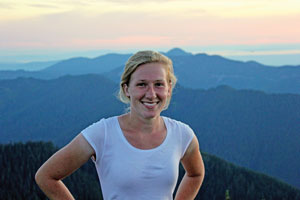1/1/2018
Hello, Real Life!
Sylvia Schaap

Rewind to a time before graduation; I recall saying things about the real world and how eager I was to finally get there.
Fast forward half a year: I’ve entered that real world. The one that can be quite a shocker for someone who’s spent years learning about plants off paper.
I know I’m in real life now because I’m thinking about school the way my parents talked about it when I complained about my rough student life. That was a good period of life, eh? Ahh, the life of a student …
The transition from the exams and lectures to growing plants was like a gravel road. It looks deceptively smooth, and it can be in spots, but then come the potholes and bumps and jiggles, with clouds of dust showing exactly where you had been and how fast you were going.
You learn so much, perhaps more, from an experience with a struggling crop than by cramming in pages of good solid facts before an exam. This type of learning—where mistake-making and decision consequences are in the living 3-D—is very gradual and sometimes frustratingly painful. You don’t realize what you’ve learned until you look back at yourself before the experience. At school, you’re so aware of learning that sometimes your brain aches with the information coming your way. Pencils and papers, facts and figures, memorization and problem-solving is all just part of the job now, but it’s real life because fresh air, sweat, sunrises, tears and dirt go with it.
The biggest similarity between student life and “real-life” horticulture is the amount of information floating around. Growers to growers, professors and researchers to growers, growers to customers and the public ... there’s still so much to learn! Plus, Google is still a well-used tool, although now most Google searches I do are on my phone as I’m standing befuddled in a crop and much less often while sitting at a desk.
If I could have told myself certain things going into this job and going forward, one would be: don’t be stubborn and shy and scared of looking ignorant because: a) Hate to break it to you-with-a-fancy-degree, but (in a whisper) you are; and b) Not taking advantage of the help available is ignorant. Mentors are like banks of knowledge and employment offices for questions. At work, they want my questions and tell me they love answering them, and this is invaluable for a newbie like me.
Although there are similarities, it’s the differences between the two phases of life that make me realize that I’m finally in this real-life thing now. When it comes to what I do know, carrying over what I learned during my student life and putting it to use in this real-life thing was more difficult than I expected. Sitting in class, it all seemed so simple and straightforward. To eliminate disease incidence, the professor would enthusiastically swipe off one side of the disease triangle with her hand and dust off the chalk … voila! Disease would not occur if one of the three sides of the triangle (virulent pathogen, conducive environment or susceptible host) was missing. Of course, the science behind it was complicated and fascinating. But the execution isn’t the straightforward cause-and-effect type of management we learned out of the textbook … at least not in my world.
What we learned in school were either broad concepts or very specific cases and it gets difficult to apply those to the specific situation, crop, weather, timing, etc.—especially when said crop is gasping its last at your feet. It’s also tricky to remember, sort through and apply four years of scientific facts to make good decisions on watering, feeding, environments and treatments on real live plants. I was really looking forward to applying everything I learned in this job and trying to piece it all together is a big part of what I enjoy about growing, but boy, did I ever underestimate the challenge! Each little management decision has an effect in a big way, especially in propagation, from misting intervals and timing of watering to ventilation and humidity settings.
Knowing the science behind it all gives things rhyme and reason, which makes decision-making both easier and more challenging. Having to sort through the various ways of carrying out the results of a decision sometimes requires a physical pause while I have an inner debate supported by bits and pieces of information that was once scratched out on an exam (and perhaps also by a quick Google search or a question on the Growers Only WhatsApp group).
What it comes down to is the scientific background provided by my student life is being rigorously tested and proven by my “real life.”
Now, if only I could rewind to a time before graduation to tell myself to really keep a better eye on those sneaky lavender plugs. GT
Sylvia Schaap works in IPM at Qualitree Propagators in British Columbia, Canada, spending free time hiking, hunting, writing and drawing in mountains she now calls home.